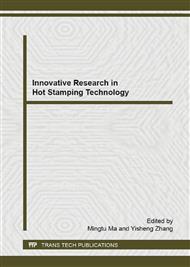p.202
p.207
p.211
p.215
p.219
p.223
p.232
p.237
p.244
Warm Stamping of the 3rd Generation Sheet Steel for Automobiles
Abstract:
The advantages and disadvantages of the conventional hot stamping steel and the hot tamping technology were shortly reviewed. It was proposed that new type steel with relative low austenization temperature and air hardening ability should be designed and produced to overcome the surface oxidation and avoid the complexity of cooling system of the stamping dies. In this study, it was shown that the 3rd generation sheet steel with medium-Mn composition could be austenized and pressed at 700-750°C and air cooled into automobile parts with strength no less than 1.5GPa and ductility larger than 12%. This new steel and corresponding forming technology were called warm stamping technology, which overcomes the disadvantages of the conventional hot stamping steel. The fabrication trials of the automobile parts in the automobile industries were demonstrated with high strength and relative good ductility. It was concluded that the 3rd generation sheet steel and the warm stamping technology could be applied to replace the conventional hot stamping steel and conventional hot stamping technology in near future.
Info:
Periodical:
Pages:
219-222
Citation:
Online since:
December 2014
Authors:
Price:
Сopyright:
© 2015 Trans Tech Publications Ltd. All Rights Reserved
Share:
Citation:


